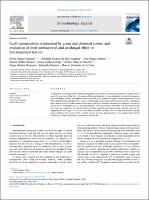| dc.contributor.author | Asmat-Campos, David | |
| dc.contributor.author | Montes de Oca-Vásquez, Gabriela | |
| dc.contributor.author | Rojas-Jaimes, Jesús | |
| dc.contributor.author | Delfín-Narciso, Daniel | |
| dc.contributor.author | Juárez-Cortijo, Luisa | |
| dc.contributor.author | Nazario-Naveda, Renny | |
| dc.contributor.author | Batista Menezes, Diego | |
| dc.contributor.author | Pereira, Reinaldo | |
| dc.contributor.author | Simbrón de la Cruz, Marcos | |
| dc.date.accessioned | 2023-11-02T14:29:28Z | |
| dc.date.available | 2023-11-02T14:29:28Z | |
| dc.date.issued | 2023-01-29 | |
| dc.identifier.uri | https://hdl.handle.net/20.500.13067/2737 | |
| dc.description.abstract | The potential for the application of metal-containing nanomaterials at the nanoscale promotes the opportunity to search for new methods for their elaboration, with special attention to those sustainable methods. In response to these challenges, we have investigated a new method for green synthesis of cuprous oxide nanoparticles (Cu2O NPs) using Myrciaria dubia juice as an organic reductant and, comparing it with chemical synthesis, evaluating in both cases the influence of the volume of the organic (juice) and chemical (ascorbic acid) reductants, for which a large number of techniques such as spectrophotometry, EDX spectrometry, TEM, SEM, DLS, FTIR spectroscopy have been used. Likewise, the nanomaterial with better morphological characteristics, stability, and size homogeneity has been applied in the functionalization of textiles by means of in situ and post-synthesis impregnation methods. The success of the synthesis process has been demonstrated by the antimicrobial activity (bacteria and fungi) of textiles impregnated with Cu2O NPs. | es_PE |
| dc.format | application/pdf | es_PE |
| dc.language.iso | eng | es_PE |
| dc.publisher | Elsevier | es_PE |
| dc.rights | info:eu-repo/semantics/openAccess | es_PE |
| dc.rights.uri | https://creativecommons.org/licenses/by-nc-nd/4.0/ | es_PE |
| dc.subject | Cuprous oxide nanoparticles | es_PE |
| dc.subject | Green synthesis | es_PE |
| dc.subject | Textile functionalization | es_PE |
| dc.subject | Antimicrobial activity | es_PE |
| dc.title | Cu2O nanoparticles synthesized by green and chemical routes, and evaluation of their antibacterial and antifungal effect on functionalized textiles | es_PE |
| dc.type | info:eu-repo/semantics/article | es_PE |
| dc.identifier.journal | Biotechnology Reports | es_PE |
| dc.identifier.doi | https://doi.org/10.1016/j.btre.2023.e00785 | |
| dc.subject.ocde | https://purl.org/pe-repo/ocde/ford#2.07.00 | es_PE |
| dc.source.volume | 37 | es_PE |
| dc.source.issue | 2023 | es_PE |
| dc.source.beginpage | 1 | es_PE |
| dc.source.endpage | 9 | es_PE |


